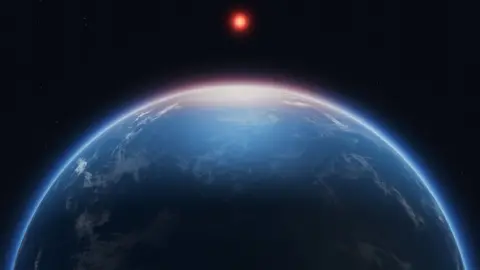
Mary Gilmore, Staff Writer
On Wednesday, Apr. 16, a team of astronomers found evidence of an unexpected atmospheric gas while studying a star adjacent to a planet. The gas is dimethyl sulfide and is only known to be produced by living organisms.
The James Webb Space Telescope faced the host star of the Planet K2-18b for nearly six hours. During that time, the planet passed in front of the star during its orbit. The telescope was able to pick up fingerprints of two molecules that were compared to Earth’s molecules. The molecules showed intense similarities to Earth’s dimethyl sulfide and dimethyl disulfide. These gasses, when produced on Earth, are only produced by live microbials.
According to NASA, Planet K2-18b is just over 120 light-years away from Earth, which is relatively close on the galactic scale. Its name represents the first planet in the 18th planetary system found by the extended NASA Kepler mission, K2. The planet is eight times larger than Earth, with a volume that is eighteen times bigger. This means that while it’s larger, it’s less dense, indicating a lot of water on this planet. But it can also have a large atmosphere, which would also contribute to the low density.
Some have speculated the planet is most likely just filled with gas. However, a planet like this would be inhabitable for life forms, making the discovery of dimethyl sulfide confusing. University of Cambridge astronomer and professor Nikku Madhusudhan suggested a different option, one that has only ever been hypothesized. Madhusudhan proposed that the planet is a “Hycean world,” which means hydrogen-over-ocean.
Astronomers predict that Hycean worlds are planets with global oceans many times deeper than Earth’s oceans and without any continents. These oceans are covered by massive hydrogen atmospheres that are thousands of miles high. A Hycean planet would also be hospitable for microorganisms due to a large, temperate ocean.
“This is an independent line of evidence, using a different instrument than we did before and a different wavelength range of light, where there is no overlap with the previous observations. A Hycean world with an ocean that is teeming with life is the scenario that best fits,” said Madhusudhan, according to Forbes, after an experiment to test the gas levels again.
While Madhusudhan believes in her findings and the hypothesis around the Hycean world, many are still skeptical. Scientists, like astronomer Daniel Apai, have chimed in stating that the dimethyl sulfide signal was too weak to confirm whether it truly is dimethyl sulfide. Moreover, Apai believes that the Hycean planet hypothesis is simply a hypothesis with no real proof that it could exist.
Leave a Reply